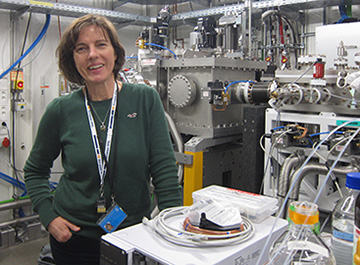
Saša Bajt heads a group at the Deutsches Elektronen-Synchrotron (DESY) that develops cutting-edge optics for high-energy X-ray science. [Image: Courtesy of S. Bajt]
Since breaking ground on its first particle accelerator 60 years ago, the Deutsches Elektronen-Synchrotron (DESY), Germany’s huge high-energy-physics research center, has notched impressive achievements in particle physics, astrophysics and accelerator science. In the past decade and a half, moreover, the center has also emerged as a powerhouse in photon science. DESY has achieved that status both through its own FLASH and PETRA III X-ray sources, and through regional and international collaborations such as the European X-ray Free-Electron Laser (XFEL) and the Hamburg-based Center for Free-Electron Laser Science (CFEL).
Yet getting those superb X-ray light sources to do anything useful requires a lot of work behind the scenes on cutting-edge optics—for pulse focusing, compression and more. Some of these problems, long since solved for infrared and visible-light lasers, become devilishly difficult in the higher-energy extreme-ultraviolet (EUV) and X-ray realm. OPN recently spoke with OSA Fellow Saša Bajt, the head of DESY’s Multilayer Optics Group, about some of those challenges—and the road ahead for DESY’s photon science effort.
Accelerator roots
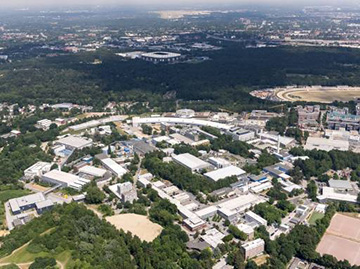
DESY’s Hamburg campus. [Image: © DESY / Reimo Schaaf]
Based in the state of Hamburg, Germany—and with a €230 million budget funded mainly by the German Federal Ministry of Education and Research and by the German states of Hamburg and Brandenburg—DESY today employs 2,300 persons, including 650 scientists. Thousands of other international scientists cycle through each year to use the center’s state-of-the-art facilities.
For its first 30 years, the institution did not focus much on its potential in photon science. Instead, the early facilities—the eponymous DESY circular synchrotron, opened for use in 1960; the vast DORIS double storage ring, unveiled in the early 1970s; and other successor installations—aimed at boosting particles and electrons to relativistic energies, in the quest to find new elementary particles and probe quantum electrodynamics. In 1980, another facility, the HASYLAB, added experimental suites to use the by-product synchrotron radiation from the accelerators to answer questions in molecular biology, materials science and other areas.
Moving to XFELs
Even today, DESY remains strong in accelerator science and basic physics, Saša Bajt notes, with close ties to other leading facilities such as CERN. In the late 1990s, however, the institution started to look at the possibility of a different kind of installation: an X-ray free-electron laser.
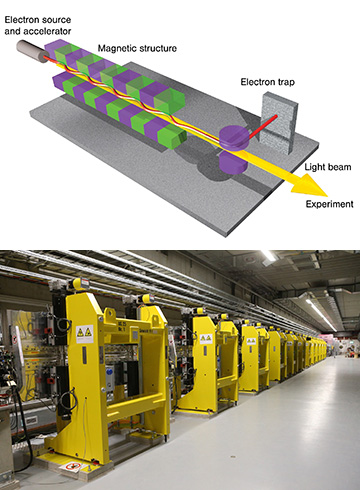
Top: An X-ray free-electron laser operates by passing electrons, sped up to relativistic velocities in a linear accelerator, through a magnetic undulator, giving rise to laser-like X-ray flashes. Bottom: Undulator chain at DESY’s FLASH 2 FEL. [Images: © DESY 2006, 2015]
XFELs were a natural fit with DESY’s accelerator operation. These lasers work by pushing electrons to relativistic velocities, and then passing them through a magnetic “undulator,” which bunches the electrons and causes the resulting synchrotron radiation to add coherently. That leads to a laser-like coherent beam of short X-ray pulses.
DESY administrators thus began work on adding an X-ray laser capability to a linear-collider prototype that was already on the drawing boards. The end result of that work, opened in 2005, was FLASH (the Free-electron LASer in Hamburg)—the first FEL, Bajt observes, in the soft-X-ray regime.
Tied to a superconducting linear accelerator several hundred meters long, and capable of efficiently pumping out 50-fs-wide pulses of X-ray photons, FLASH became a keystone of DESY’s photon science effort. It also served as a prototype for a much larger facility—the 3.4-km-long European XFEL, a 10-country collaborative project launched in 2017, which can generate 27,000 ultrashort, high-intensity X-ray pulses per second.
In addition to these FELs, in 2010, DESY fitted out its third-generation synchrotron storage ring facility, PETRA III—originally targeted for particle physics—with 14 beamlines for other experiments that require brilliant, tightly focused, hard X-rays.
X-ray optics: “Terra incognita”
These facilities opened the prospect for interdisciplinary, cutting-edge research on the structure of material, accessible only with high-brightness, focused X-rays. But getting there required new optics to handle these extremely intense, high-energy beams. Which is where Bajt’s team comes in.
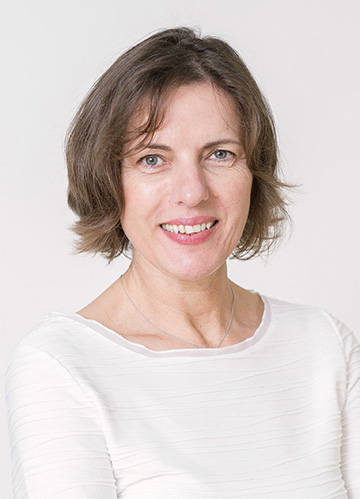
Saša Bajt. [Image: Courtesy of S. Bajt]
“We have these great new X-ray sources, and they offer new opportunities—there’s a lot you can do with them,” Bajt says. “But if we want to really utilize them, we also need to develop new optical devices. So this fundamental work is very important.”
Bajt herself got involved with DESY science soon after the launch of FLASH, when she was still working as a research scientist at the Lawrence Livermore National Laboratory (LLNL) in the United States. At LLNL, Bajt was working on multilayer optics for EUV lithography. It occurred to her and her colleagues that similar approaches “could be applied also in these new projects—like developing mirrors for free-electron lasers like FLASH.”
When she started the work as a side project at LLNL, it seemed “like I worked in terra incognita,” Bajt recalls. “Basically, I had some simulation results with very large error bars. No one knew what would happen when you put the optic into the beam—whether it would survive or not.” She adds that it was effectively impossible to get scarce beam time solely to test a new optical device. That meant that she had to piggyback on other experiments for her tests.
DESY’s X-ray optics effort
Fortunately, the experiments worked—and in 2008, Bajt was invited to come to DESY and start a dedicated group developing X-ray optics for extreme conditions. There, she leads what she calls “a small but very motivated team” that focuses on both the fundamental science of X-ray optics, and on developing and preparing functional optics in support of specific science experiments in which she acts as a P.I. or collaborator. The “motivated” part of her description of the team is important, she adds, since “actually we do everything—from design to fabrication to execution and measurement.”
One of the group’s particular successes—the genesis for which, Bajt says, dates back to her LLNL days, but which she could focus on only after coming to DESY—has been the development of multilayer Laue lenses (MLLs). These lenses involve depositing thousands of nanometer-scale layers at varying angles, to satisfy Bragg’s law and focus the beam, while at the same time also meeting the Fresnel zone-plate condition, to ensure that the beam elements interfere constructively at the focal point. The requirement is simply stated—but meeting both conditions at nanometer-scale precision was a high bar to clear.
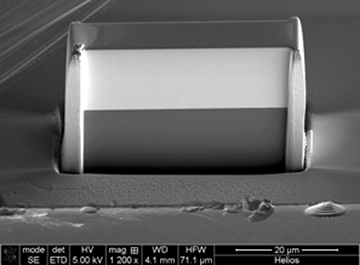
In 2015, Bajt and her team designed, fabricated and demonstrated 40-micron-wide multilayer Laue lenses capable of focusing hard X-rays to diameters of less than 10 nm. [Image: S. Bajt/DESY]
Bajt’s team cleared it with a new fabrication approach—one that has been used to build lenses that can focus a synchrotron X-ray beam to diameters of less than 10 nm, the smallest X-ray focus yet achieved. That capability, she says, opens up applications in imaging biological samples at high resolution, but with a lower X-ray dose, crucial to avoid damaging the sample in many bio-imaging experiments. Other applications include nanometer-resolution studies of polycrystalline forms, useful in battery research and other materials science; and addressing fundamental-physics questions such as the nonlinear interaction of intense X-rays with matter.
Looking ahead
For the MLLs in particular, Bajt says her “long-term goal” is to get the focal spot down to 1 nm diameter, which would offer resolution comparable to that of scanning electron microscopy. “But of course,” she adds, “the closer you get to that, the harder it gets.” One particular challenge is developing the diagnostics to even measure the results and get a fix on errors in a reasonable time—crucial, because the lenses themselves can take a week to grow in the lab. “You can’t improve something,” she says, “if you don’t know how to measure it, or where the errors come from.”
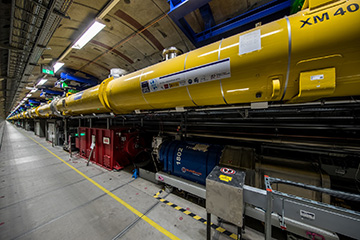
A portion of the 2.1-km-long underground superconducting linear accelerator at the European X-ray Free Electron Laser. The complete European XFEL facility, a full 3.4 km in length, stretches from the DESY facility in Hamburg to the neighboring city of Schenefeld in the state of Schleswig-Holstein. [Image: © DESY 2017]
Ongoing development at DESY, meanwhile, could yield other opportunities. Bajt notes that much has changed on the campus in the more than a decade she’s been there, with the development of new experimental halls; of additional beamlines, including those for PETRA III; and of the massive European XFEL, a project on which DESY had lead responsibility. “For the last 10 years, DESY has really been a big construction site,” Bajt laughs, “and it will probably remain like that for the foreseeable future.”
Projects in the planning stage right now include possible upgrades to FLASH, under the working title FLASH 2020; and PETRA IV, a potential makeover of the 2300-m-long PETRA storage ring that would produce an even higher flux of even more tightly focused X-rays. Bajt is particularly excited about PETRA IV, she says. That’s because such a source would be an ideal fit for the lenses that her team has developed, and could further expand the tool’s horizons for investigating biology on a molecular scale.
International ties
Meanwhile, the combination of access to exquisite light sources and cutting-edge optics continues to bear fruit in remarkable science at DESY today. In August 2019, DESY scientists working at the European XFEL revealed the first high-speed microscopic movies created with a hard-X-ray FEL. And in a paper published this past September, DESY researchers collaborated with scientists from other institutions on a fundamental study of high-intensity X-ray laser light’s interaction with matter, in experiments carried out at the Linac Coherent Light Source (LCLS) of the Stanford Linear Accelerator Center (SLAC) in the United States.
Those research stories and others, Bajt notes, underscore the importance of regional and international collaborations in her own work—and that of DESY as a whole. “We work on very complex, difficult problems,” she says, “and we can’t have all of the expertise in our group.” That’s particularly true, she adds, because each experiment carries high stakes. “We’re working on facilities that are heavily oversubscribed, and it’s extremely expensive to run these experiments,” according to Bajt. “We have to be successful … so you try to team up with the best collaborators you can find.”

[Image: © DESY 2013]
One collaboration vehicle that Bajt has found particularly valuable has been CFEL, a joint venture involving DESY, the Max Planck Society and the University of Hamburg—which she calls a “unique enterprise” that was “really designed to bring together scientists to advance science with these new-generation light sources and lasers.” The connection with this interdisciplinary body, according to Bajt, has created opportunities to do science at a range of international facilities, and also to access extra resources and expertise for her group’s work.
“If you look at our publications,” Bajt says, reflecting on these and other collaborations, “it’s not uncommon to have 50 to maybe even 100 people on a coauthor list. And really,” she stresses, “everyone contributed something important. There are things that might seem small—but if those things aren’t done right, the experiment won’t work.”
